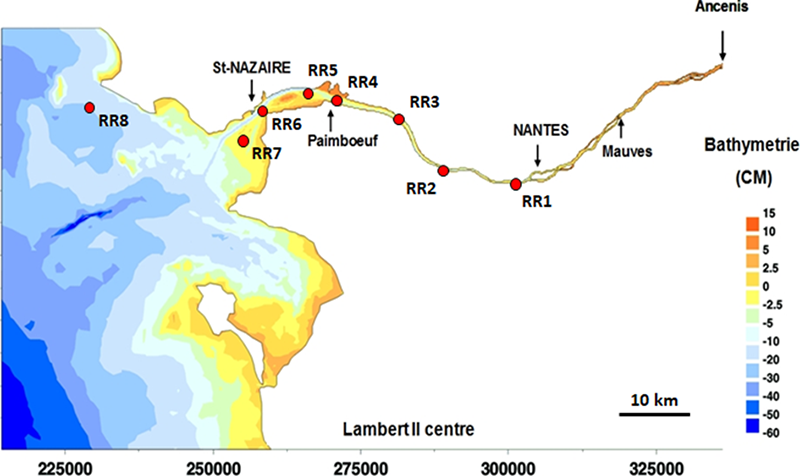LIFE REVERS’EAU project

The objective of the European project LIFE REVERS’EAU is to define the potential role of phosphorus and chemical reducing species stocks contained in the surface sediment in the aggravation of hypoxia episodes of the Loire estuary.
Today, the Loire estuary is considered to be in average condition with regard to the IPR of the EU Water Directive. Indeed, some migratory species do not manage to go up the Loire.
Three hypotheses are posed to explain it:
- Problems of water quality emanating from the whole basin: this field is investigated by the Water Agency Loire-Bretagne via the actions led in the Master Plan for the development and management of the Loire-Bretagne waters.
- Problems with lateral connectivity between the Loire estuary and the adjacent marsh areas: some fish species cannot reach the spawning grounds because of the presence of obstacles and artificialization phenomena (ecological and sedimentary continuity)
- Problems of anoxia at the level of the muddy plug of the estuary, the functioning of which is currently poorly understood. In the estuaries, the environmental conditions (tidal coefficient, turbidity, water temperature, river flow, upstream inputs of nutritive salts…) seem to be conducive to dissolved oxygen deficits. This deficit is partly due to biological processes of oxygen consumption (nitrification, degradation of organic matter) and seems to cause an ecological dysfunction jeopardizing the survival of a significant number of organisms (barrier for migratory fish or increase of their sensitivity to contaminants).
It is on this third point, considered particularly probable, that the OXYMORE 2 action of the PI LIFE REVERS’EAU focuses.
Indeed, in the Loire, dissolved oxygen deficits have been one of the recurrent problems of the estuary for several decades. Various studies reported in the summary of the GIP Loire-Estuaire highlight the influence of the degradation processes of organic matter in the consumption of oxygen, but the exhaustive diagnosis of the causes remains complex, because of the multiplicity of biogeochemical processes at work in an estuary.

To help identify this problem, the « Laboratoire de Planétologie et Géodynamique » is conducting a study focused on the potential role of phosphorus stocks and chemical reducing species contained in the surface sediment in the aggravation of hypoxia episodes.
The action is divided into three workpackages, supporting two theses and a post-doctoral contract:
WP1: Characterization of phosphorus stocks and sediment reactivity in different estuarine compartments
WP2: Quantification of stocks and mobilization kinetics of inherited phosphorus at the estuary scale by spatial and temporal modeling
WP3: Governance and recommendations to reduce the impact of legacy phosphorus on the generation of hypoxic episodes

Links with other projects
- OXYMORE 1 (LPG-Angers): Influence in the maintenance of hypoxia of phosphorus storage/removal processes in the Loire estuary
- REBELRED (LPG, Angers): Benthic recycling of REDox elements and associated nutrients through an estuary subject to hypoxia: the Loire River
- COMBAC (LPG-Angers): Bacterial communities associated with biogeochemical transformations of particles across the Loire estuary
- Trans-P (INRAE, Rennes): Transfer of phosphorus from agricultural land to watercourses: stocks and flows, from observation to modeling.
- MICROPOP (IFREMER, Brest): Role of MICRO-organisms in the dynamics of phosphorus in estuarine environments: importance for phytoplankton production in coastal areas
Scientific collaborations
- LPG (Angers-Nantes) : Barras, E. Beneteau, H. Capiaux, E. Geslin, H. Howa, V. Hulot, P. Launeau, T. Lebeau, G. Maillet, E. Metzger, M. Mojtahid, A. Mouret, S. Sanchez
- EPOC (Bordeaux): S. Bujan, B. Deflandre, H. Derriennic, N. Savoye, S. Schmidt
- LSCE (Gif/Yvette): B. Bombled, C Rabouille, E. Viollier
- M2C (Rouen) : J.Deloffre, V. Mesnage, M. Simon
- IPREM (Pau) : A. Thibault de Chanvalon
- UNIMES (Nîmes) : S. Rigaud
- IFREMER (Nantes): N. Briant, J. Knoery, E. Ponzevera, P. Souchu
The project coordinator is Grégoire Maillet, Senior Lecturer at the University of Angers.
And, to learn more about the context of the project, visit the website developed by European Commission


